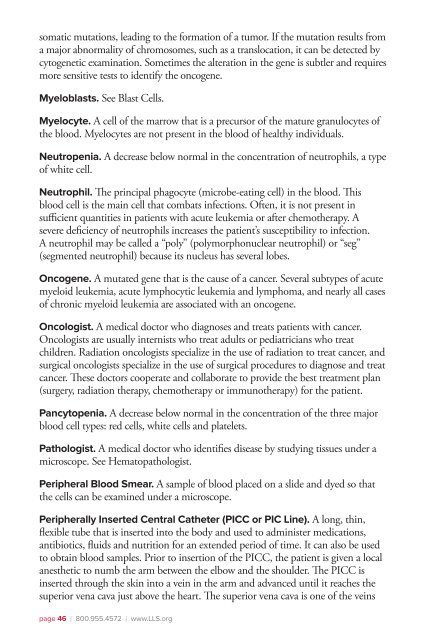Acute Myeloid Leukemia - The Leukemia & Lymphoma Society
Acute Myeloid Leukemia - The Leukemia & Lymphoma Society
Acute Myeloid Leukemia - The Leukemia & Lymphoma Society
- No tags were found...
You also want an ePaper? Increase the reach of your titles
YUMPU automatically turns print PDFs into web optimized ePapers that Google loves.
somatic mutations, leading to the formation of a tumor. If the mutation results froma major abnormality of chromosomes, such as a translocation, it can be detected bycytogenetic examination. Sometimes the alteration in the gene is subtler and requiresmore sensitive tests to identify the oncogene.Myeloblasts. See Blast Cells.Myelocyte. A cell of the marrow that is a precursor of the mature granulocytes ofthe blood. Myelocytes are not present in the blood of healthy individuals.Neutropenia. A decrease below normal in the concentration of neutrophils, a typeof white cell.Neutrophil. <strong>The</strong> principal phagocyte (microbe-eating cell) in the blood. Thisblood cell is the main cell that combats infections. Often, it is not present insufficient quantities in patients with acute leukemia or after chemotherapy. Asevere deficiency of neutrophils increases the patient’s susceptibility to infection.A neutrophil may be called a “poly” (polymorphonuclear neutrophil) or “seg”(segmented neutrophil) because its nucleus has several lobes.Oncogene. A mutated gene that is the cause of a cancer. Several subtypes of acutemyeloid leukemia, acute lymphocytic leukemia and lymphoma, and nearly all casesof chronic myeloid leukemia are associated with an oncogene.Oncologist. A medical doctor who diagnoses and treats patients with cancer.Oncologists are usually internists who treat adults or pediatricians who treatchildren. Radiation oncologists specialize in the use of radiation to treat cancer, andsurgical oncologists specialize in the use of surgical procedures to diagnose and treatcancer. <strong>The</strong>se doctors cooperate and collaborate to provide the best treatment plan(surgery, radiation therapy, chemotherapy or immunotherapy) for the patient.Pancytopenia. A decrease below normal in the concentration of the three majorblood cell types: red cells, white cells and platelets.Pathologist. A medical doctor who identifies disease by studying tissues under amicroscope. See Hematopathologist.Peripheral Blood Smear. A sample of blood placed on a slide and dyed so thatthe cells can be examined under a microscope.Peripherally Inserted Central Catheter (PICC or PIC Line). A long, thin,flexible tube that is inserted into the body and used to administer medications,antibiotics, fluids and nutrition for an extended period of time. It can also be usedto obtain blood samples. Prior to insertion of the PICC, the patient is given a localanesthetic to numb the arm between the elbow and the shoulder. <strong>The</strong> PICC isinserted through the skin into a vein in the arm and advanced until it reaches thesuperior vena cava just above the heart. <strong>The</strong> superior vena cava is one of the veinspage 46 I 800.955.4572 I www.LLS.org
















